This article was co-authored by Laura Marusinec, MD. Dr. Marusinec is a board certified Pediatrician at the Children's Hospital of Wisconsin, where she is on the Clinical Practice Council. She received her M.D. from the Medical College of Wisconsin School of Medicine in 1995 and completed her residency at the Medical College of Wisconsin in Pediatrics in 1998. She is a member of the American Medical Writers Association and the Society for Pediatric Urgent Care.
There are 17 references cited in this article, which can be found at the bottom of the page.
wikiHow marks an article as reader-approved once it receives enough positive feedback. This article received 18 testimonials and 87% of readers who voted found it helpful, earning it our reader-approved status.
This article has been viewed 909,285 times.
Fractured phalanges--or broken fingers--are one of the injuries most commonly seen by emergency room physicians. But before you head to the hospital, it may be a good idea to try to determine if your finger may indeed be broken. A sprain or ligament tear will be quite painful, but they do not require trips to the emergency room. A look with a small doctor can be seen if your finger is sprained or has a ligament tear. A broken bone, on the other hand, can result in internal bleeding or other damage that requires immediate medical care.
Steps
Recognizing the Signs of a Broken Finger
-
1Check for pain and tenderness. The first sign of a fractured finger is pain. Your experience of pain and depends on the severity of your finger fracture. After sustaining an injury to your finger, treat it carefully and keep an eye on your pain levels.[1]
- It can be hard to identify if you have a finger fracture right away, because acute pain and tenderness are also symptoms of dislocations and sprains.
- Look for other symptoms and/or seek medical attention if you are unsure of the severity of your injury.
-
2Check for swelling and bruising. After sustaining a fracture to your finger, you will notice acute pain that is followed by swelling or bruising. This is part of your body’s natural response to injury. After fracture, your body activates the inflammatory response followed by swelling caused by fluid released into the surrounding tissues.[2]
- Swelling is often followed by bruising. This happens when the capillaries around the injury swell or burst in response to the increased fluid pressure.[3]
- It may be hard to know if your finger is fractured at first, as you still may be able to move it. After you try to move your finger, swelling and bruising begin to become apparent. The swelling may also spread to other fingers or down the palm of the hand.
- You are likely to notice swelling and bruising 5-10 minutes after your first sensations of pain in your finger.
- However, minor swelling or the absence of immediate bruising may be indicative of a sprain instead of a fracture.
Advertisement -
3Look for deformity or inability to move the finger. A finger fracture consists of a segment of the bone that is cracked or broken in one or more places. The bone deformity can show up as unusual bumps on the finger or a finger that points in a different direction.[4]
- If there are signs of misalignment, the finger is probably broken.
- You usually cannot move your finger if it is fractured because one or more sections of the bone are no longer connected.
- It is also likely that swelling and bruising makes your finger too stiff to move comfortably following any injuries.
-
4Know when to see medical attention. Go to your nearest accident and emergency department if you think you have a finger fracture. Fractures are complicated injuries and their severity is not readily apparent from external symptoms. Some fractures require more involved treatment in order to heal correctly. If you aren't sure whether an injury is a fracture, it's better to err on the side of caution and see a doctor.[5]
- If you have significant pain, swelling, bruising, or any deformity or decreased movement of your finger, seek medical attention.[6]
- Children with finger injuries should always see a doctor. Young and growing bones are more susceptible to injury and to complications if those injuries aren't treated properly.
- If your fracture is not treated by a medical professional, then it is possible that your finger and hand will remain painfully stiff when you try to move your finger.
- A bone that re-knits out of proper alignment can further hinder your successful use of your hand.
Diagnosing a Broken Finger at the Doctor’s Office
-
1Get a physical exam. If you suspect a finger fracture, seek medical attention. During a physical exam, your doctor evaluates your injury and determines the severity of your fracture.[7]
- Your doctor will take a note of your finger’s range of motion by asking you to make a fist. She will also look for visual signs, such as swelling, bruising, and bone deformities.
- Your doctor will also manually examine your finger to look for signs of reduced blood flow to the area and nerve impingement.
-
2Ask for an imaging test. If your doctor cannot determine during a physical exam whether you have a fractured finger, she may recommend an imaging test to diagnose the fracture. These include X-ray, CT scan or an MRI.
- X-rays are often the first imaging tests used to diagnose a fracture. Your doctor places your fractured finger between an X-ray source and an X-ray detector, then sends low-level radiation waves through your finger to create the image. This process is completed within a few minutes and is painless.[8]
- A CT or computed tomography scan is constructed by putting together X-rays that scan different angles of an injury. Your doctor may decide to use a CT to create an image of your fracture if the initial X-ray’s results are inconclusive or if your doctor suspects that there are also soft tissue injuries related to the fracture.[9]
- An MRI may be needed if your doctor suspects that you have a hairline or stress fracture, the kind of fracture that is produced after repeated injuries over time. MRIs produce finer details and can also help your doctor differentiate between soft tissue injuries and hairline fractures in your finger.[10]
-
3Ask if you need a surgical consultation. Surgical consultations may be required if you have a severe fracture, such as a compound fracture. Some fractures are unstable and require surgery in order to put bone fragments back into place with aids (such as wires and screws) so that the bone can heal properly.[11]
- Any fracture that seriously hinders mobility and puts the hand far out of alignment likely requires surgery in order for the finger to regain articulate movement.
- You may be surprised at how difficult it is to execute everyday tasks without full use of all of your fingers. Professionals such as chiropractors, surgeons, artists, and mechanics require full use of their fine motor skills in order to accurately perform their jobs. Thus, caring for finger fractures is vital.
Treating a Broken Finger
-
1Ice, compress and elevate. Manage the swelling and pain by icing, compressing, and elevating the finger. The faster after the injury you give this type of first aid, the better. Make sure that you are also resting your finger.[12]
- Ice the finger. Wrap a bag of frozen vegetables or an icepack in a thin towel and apply it gently to your finger to help reduce your swelling and pain. Apply ice immediately after you sustain the injury for no longer than 20 minutes as needed.
- Compress the injury. Gently but securely wrap your finger with a soft elastic bandage to help manage the swelling and immobilize the finger. At your initial appointment with your doctor, ask if it is appropriate to keep your finger wrapped in order to reduce your risk of bringing on additional swelling and to keep from impeding movement of other fingers.
- Elevate the hand. When possible, keep your finger elevated above your heart. You may find it most comfortable to sit on a couch with your legs over the cushions and your wrist and fingers resting on the back of the couch.
- You also should not use the injured finger for everyday activities until cleared by your doctor.
-
2Ask your doctor if you need a splint. Splints are used to immobilize your fractured finger to keep it from developing further damage. A makeshift splint may be crafted out of a popsicle stick and a loose bandage until you get to the doctor for a better wrapping.[13]
- The kind of splint you need varies according to which finger is fractured. Minor fractures may benefit from “buddy taping,” which consists of immobilizing the injured finger by taping it to the finger next to it.
- A dorsal extension-block splint keeps your injured finger from bending backward. A soft splint is placed to keep your injured finger slightly and gently curved toward the palm and is held in place with soft fastenings.
- An aluminum u-shaped splint is an inflexible aluminum splint that keeps the injured finger from extending. It is placed on the back of the injured finger to keep it immobile.[14]
- In more severe cases, your doctor may apply an inflexible fiberglass splint that goes from your finger to past your wrist. It's essentially like a mini-cast for your finger.
-
3Ask your doctor if you need a surgery. Surgery is required to properly treat and heal a fracture when immobilization and time cannot effectively fix it. In general, fractures that require surgery are more complicated than those that only require immobilization.[15]
- A compound fracture, a fracture that is unstable, loose bone fragments, and a fracture that compromises a joint all require surgery because the broken pieces need to be guided back into place in order for the bone to heal in the right configuration.
-
4Take pain medicines. Your doctor may recommend you take non-steroidal anti-inflammatory drugs (NSAIDs) to help manage pain associated with a broken finger. NSAIDs work by reducing negative effects of long term inflammation, and alleviating pain and pressure put on the nerves and associated tissues. NSAIDs do not inhibit the healing process.[16]
- Common over-the-counter NSAID medications used for managing fracture pain include ibuprofen (Advil) and naproxen sodium (Aleve). You can also take acetaminophen (Tylenol), but it is not an NSAID and does not reduce inflammation.[17]
- Your doctor may also give you a codeine-based prescription medication for short term management if you experience major pain. The pain is more likely to be worse at the beginning of the healing process, and your doctor will reduce your prescription strength as the bone heals.
-
5Follow up with your doctor or specialist as directed. Your doctor may instruct you to make a follow-up appointment a few weeks after your initial treatment. She may repeat X-rays 1-2 weeks after the injury to see how it's healing. Make sure you keep any follow-up appointments to ensure that you're on the mend.
- If you have questions about your injury or anything else, contact your doctor's office.
-
6Understand the complications. In general, fractured fingers heal very well after consultation with a doctor and a 4-6 week healing period. The risks for complications following a finger fracture are minimal, but it is still good for you to be aware of them:[18]
- Joint stiffness may occur as a result of scar tissue forming around the fracture site. This can be addressed with physical therapy to strengthen the finger muscles and reduce the scar tissue.
- A section of the finger bone may rotate during the healing process, resulting in a bony deformity that may need to be addressed by surgery to help you grasp things properly.
- The two pieces of the bone may not fuse together properly, resulting in permanent instability within the fracture site. This is known as “nonunion.”
- Skin infection may occur if there are lacerations to the fracture site and they are not properly cleaned prior to surgery.
Understanding the Types of Fractures
-
1Understand finger fractures. The human hand is made up of 27 bones: 8 in the wrist (carpal bones), 5 in the palm of the hand (metacarpal bones) and three sets of phalanges in the fingers (14 bones).[19]
- The proximal phalanges are the longest part of the finger located closest to the palm of the hand. The intermediate, or middle, phalanges come next, and then the distal phalanges are the farthest out, forming the “tips” of the fingers.[20]
- Acute injuries, such as falls, accidents, and sport injuries, are the most common causes for finger fractures. Your fingertips are one of the most injury-prone areas of your body because they are involved in almost every activity you partake in throughout the day. [21] [22]
-
2Know what a stable fracture looks like. Stable fractures are defined by a broken bone but little to no displacement at either end of the break. Also known as a nondisplaced fracture, stable fractures can be difficult to identify and may demonstrate symptoms similar to other forms of trauma.[23]
-
3Know what a displaced fracture looks like. Any broken bone in which the two primary sides of the break are no longer touching or aligned is considered a displaced fracture.
-
4Know what a compound fracture looks like. A fracture in which the broken bone has been displaced and a portion of it pushed through the skin is referred to as a compound fracture. Because of the severity of the damage to the bone and the surrounding tissue, this injury always requires immediate medical attention.
-
5Know what a comminuted fracture looks like. This is a displaced fracture in which the bone has shattered into three or more pieces. This is often, but not always, associated with substantial tissue damage. The extreme pain and immobility of the affected limb that are often associated with this form of injury make it easier to diagnose.
Warnings
- Regardless of the recommendations above, if you believe you have suffered a serious injury then you must seek appropriate medical care.⧼thumbs_response⧽
References
- ↑ http://orthoinfo.aaos.org/topic.cfm?topic=a00257
- ↑ http://orthoinfo.aaos.org/topic.cfm?topic=a00257
- ↑ http://www.nationwidechildrens.org/swelling-bodys-reaction-to-injury
- ↑ http://www.nhs.uk/conditions/broken-finger/Pages/Introduction.aspx
- ↑ http://orthoinfo.aaos.org/topic.cfm?topic=a00257
- ↑ http://orthoinfo.aaos.org/topic.cfm?topic=a00257
- ↑ http://www.mayoclinic.org/diseases-conditions/broken-wrist/basics/tests-diagnosis/con-20031382
- ↑ http://www.nibib.nih.gov/science-education/science-topics/x-rays
- ↑ http://www.hopkinsmedicine.org/healthlibrary/test_procedures/orthopaedic/computed_tomography_ct_or_cat_scan_of_the_bones_92,P07649/
- ↑ http://www.mayoclinic.org/diseases-conditions/broken-wrist/basics/tests-diagnosis/con-20031382
- ↑ http://orthoinfo.aaos.org/topic.cfm?topic=a00257
- ↑ https://www.merckmanuals.com/professional/injuries-poisoning/fractures/overview-of-fractures
- ↑ http://www.medicinenet.com/broken_finger/page4.htm
- ↑ http://www.aafp.org/afp/2009/0901/p491.html
- ↑ http://www.mayoclinic.org/diseases-conditions/broken-wrist/basics/treatment/con-20031382 plus
- ↑ http://www.cfp.ca/content/60/9/817.full
- ↑ http://www.mayoclinic.org/diseases-conditions/broken-wrist/basics/treatment/con-20031382
- ↑ http://www.medicinenet.com/broken_finger/page5.htm
- ↑ http://www.medicinenet.com/broken_finger/page2.htm
- ↑ http://www.medicinenet.com/broken_finger/page2.htm
- ↑ http://www.mayoclinic.org/diseases-conditions/broken-wrist/basics/causes/con-20031382
- ↑ http://www.assh.org/handcare/hand-arm-injuries/fingertip-injury
- ↑ http://orthoinfo.aaos.org/topic.cfm?topic=a00139
About This Article
To determine if your finger is broken, check it for swelling and bruising, which could be a sign that it's broken. You'll also usually experience significant pain and tenderness if your finger is broken. If you're not able to move your finger, or if your finger looks deformed or misaligned, it's most likely broken. If you're experiencing these symptoms, visit a doctor or go to the emergency room so you can get a proper diagnosis. For tips on treating a broken finger so it heals faster, scroll down.
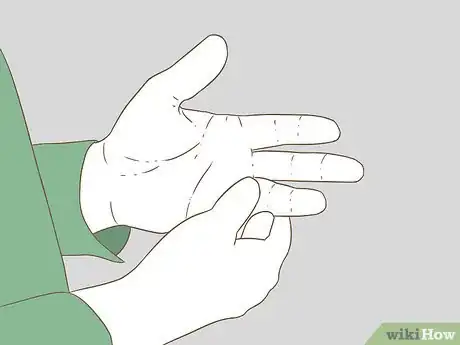
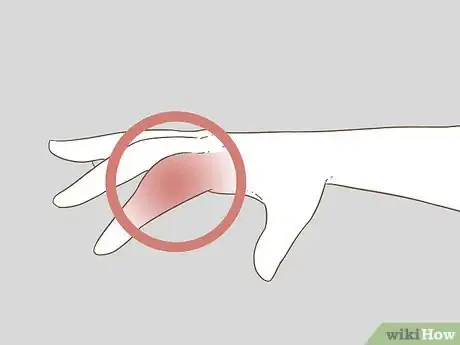
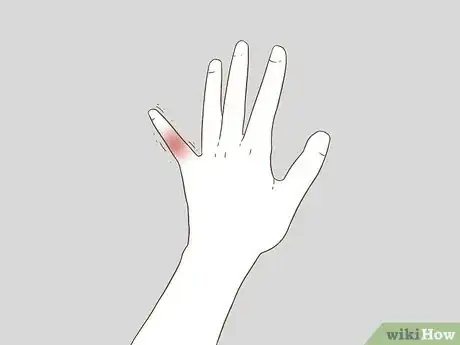



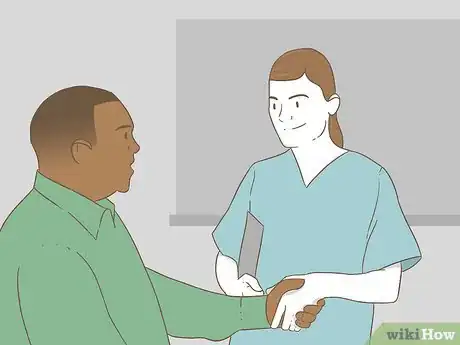

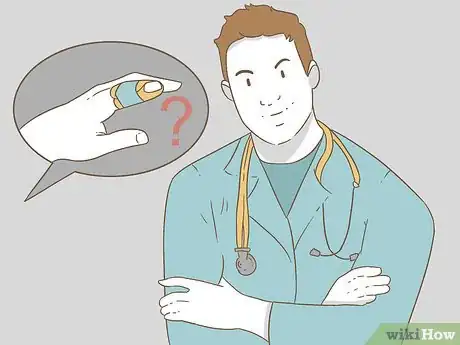

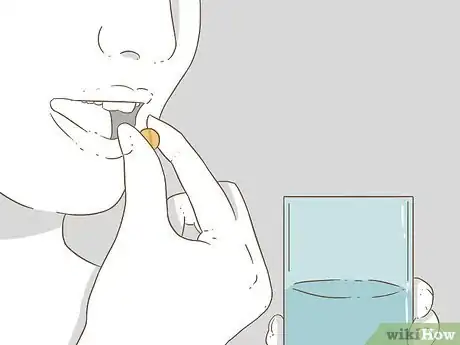
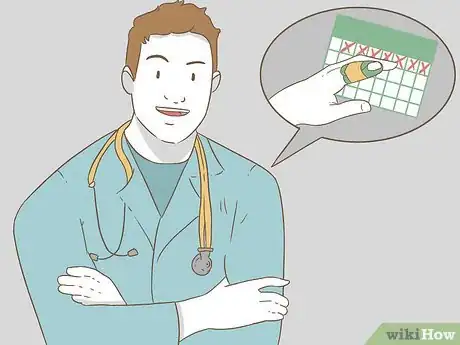


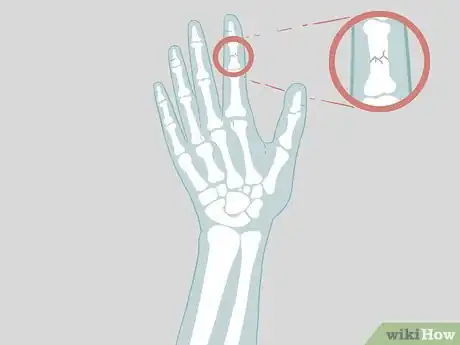

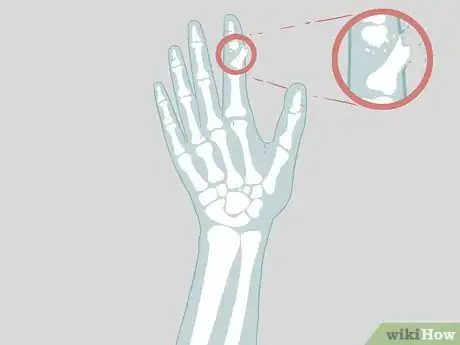
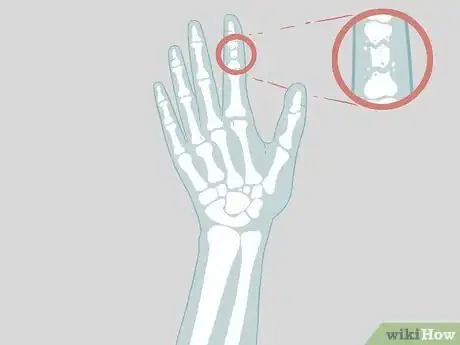

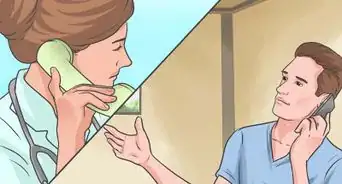




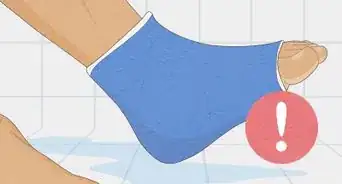
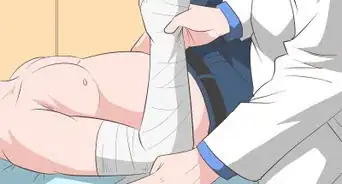
















































Medical Disclaimer
The content of this article is not intended to be a substitute for professional medical advice, examination, diagnosis, or treatment. You should always contact your doctor or other qualified healthcare professional before starting, changing, or stopping any kind of health treatment.
Read More...